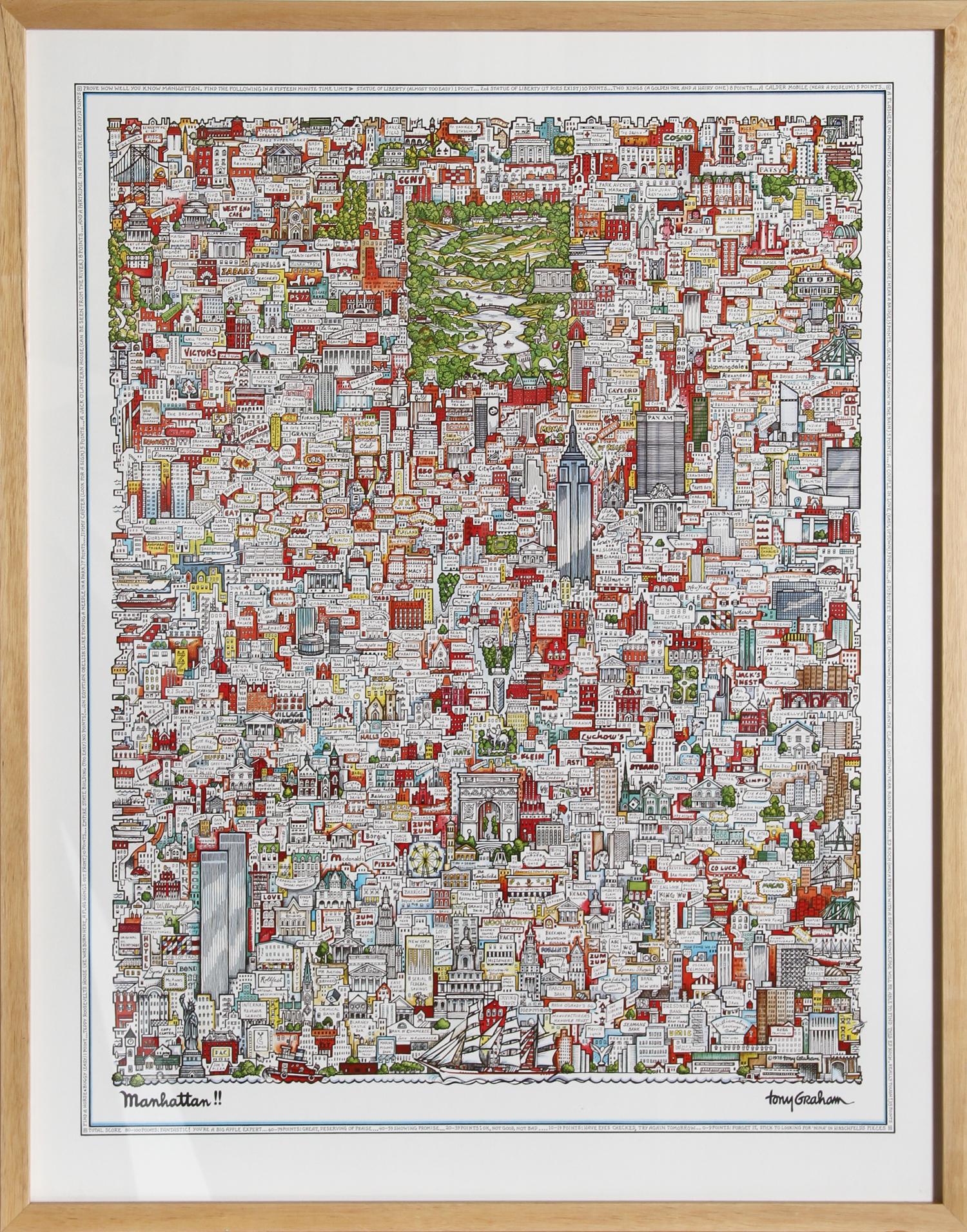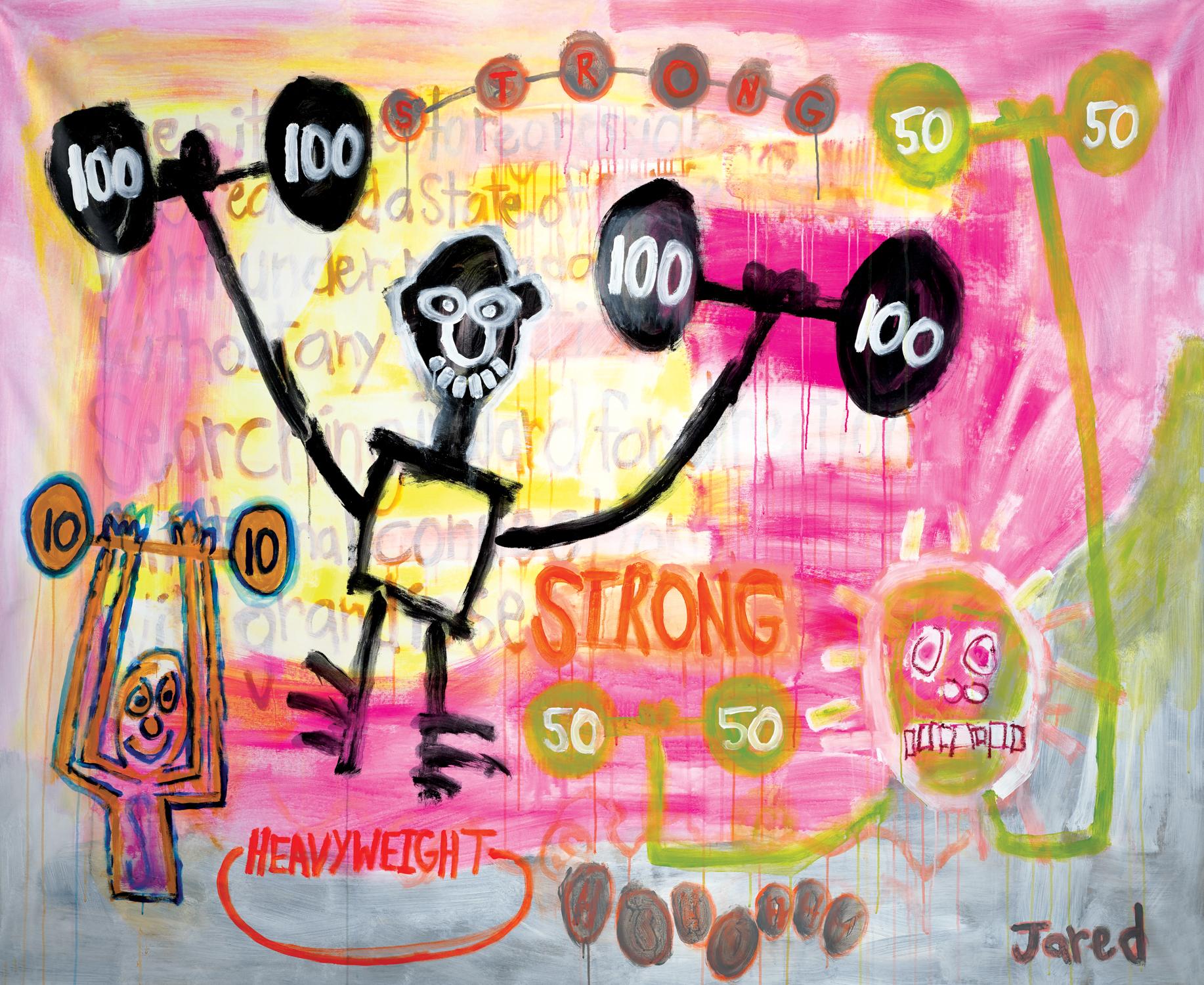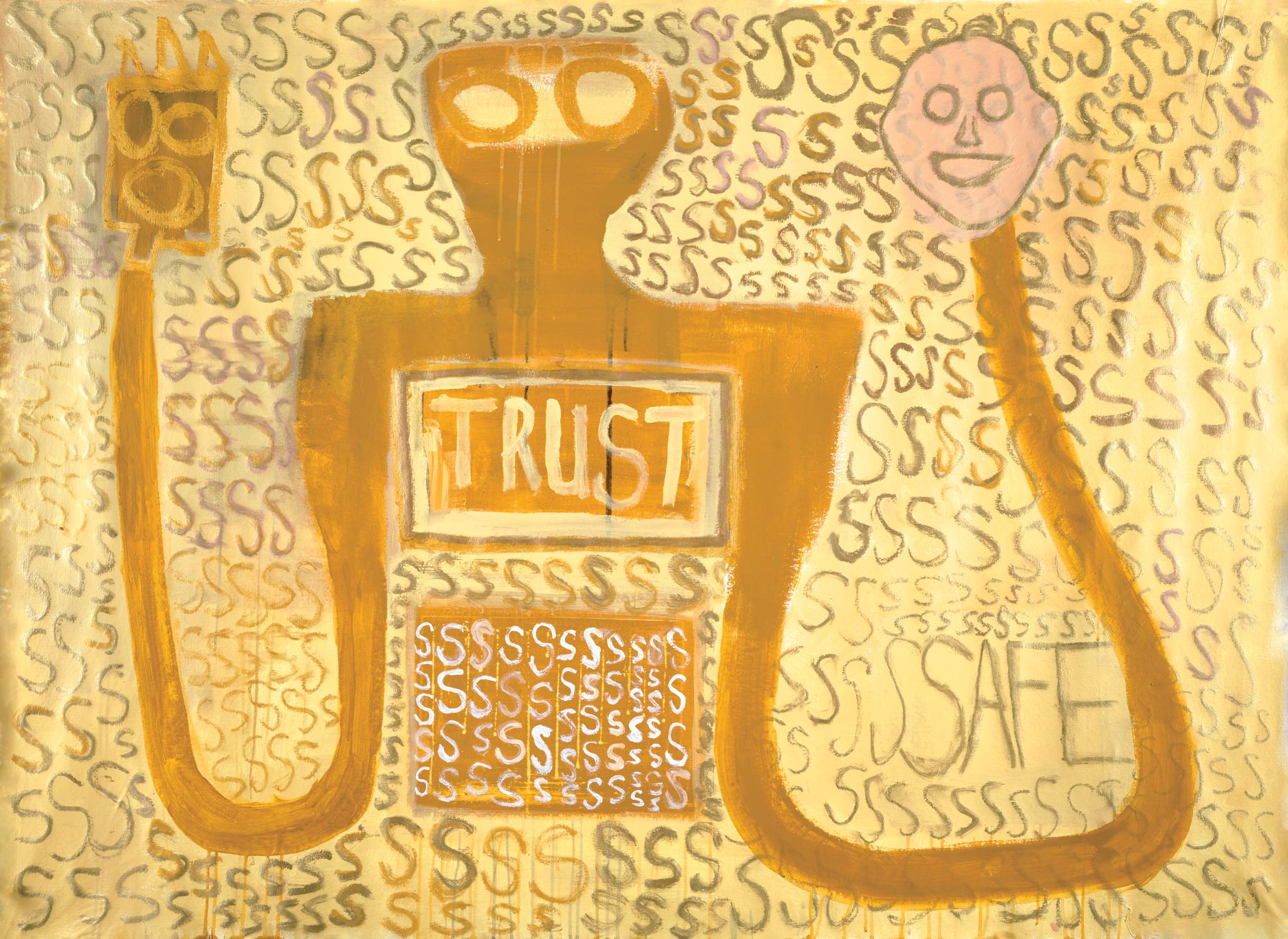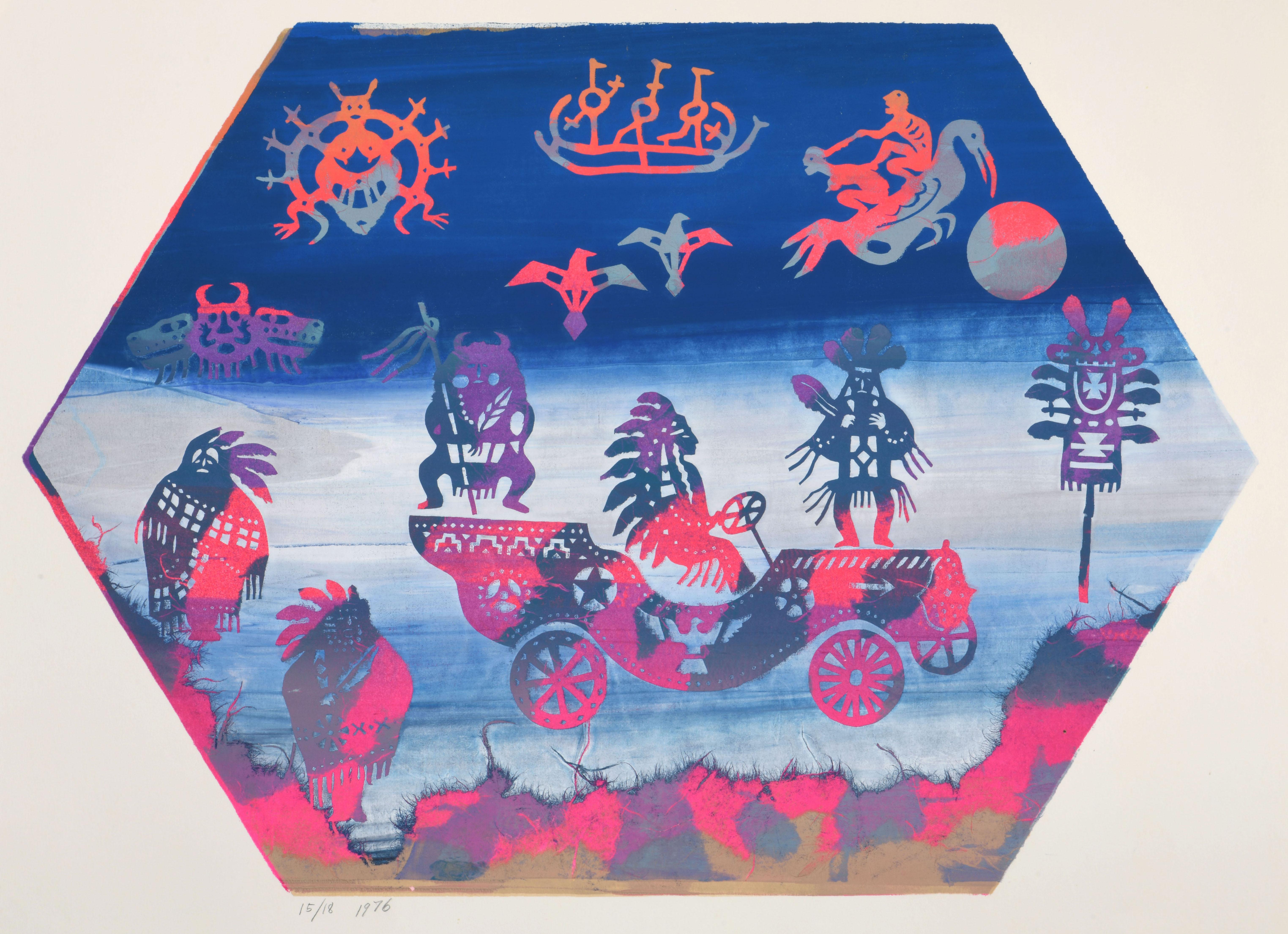Items Similar to Indian Summer in Nantuckett
Want more images or videos?
Request additional images or videos from the seller
1 of 8
Jane Wooster ScottIndian Summer in NantuckettCirca 1980
Circa 1980
About the Item
This artwork titled "Indian Summer in Nantuckett" is an original offset lithograph on wove paper by American artist Jane Wooster Scott, born 1933. It is hand signed and numbered 681/750 in pencil by the artist. The image size is 27 x 20 inches, framed size is 39 x 32.25 inches. It is beautifully framed in a custom wood frame. It is in excellent condition.
About the artist.
Jane Wooster Scott grew up in the Philadelphia area and moved West following her dream to be a movie star. She quickly learned that goal was not for her, but became the host of a talk show where she interviewed movie stars.
She photographs what she sees to recapture them later on canvas. However, few of her paintings are real, existing scenes. They are compositions drawn from her personal imagination. She has been exhibiting her work in Los Angeles and New York and most of her shows have completely sold out on opening night.
In the "Guinness Book of Records" as one of the most reproduced artists in America, Jane Wooster Scott began copying work by folk artists such as Grandma Moses and gradually evolved into her own style. A turning point for her career was a joint showing at the Ankrum Gallery in Los Angeles with her comedian friend, Jonathan Winters. It was mostly a business crowd, and she sold 40 paintings in an hour.
Her works hang in museums, in public buildings and private homes in Europe, Asia and South America as well as in the United States. She has become legendary for her exceptional scenes of America s celebrations and holidays,
Among her collectors are Aaron Spelling, Sylvester Stallone, Charles Bronson, Kenny Rogers, Farah Fawcett and Marlon Brando. Her works hang in American embassies around the world and are part of the permanent White House collection.
- Creator:Jane Wooster Scott (1933, American)
- Creation Year:Circa 1980
- Dimensions:Height: 39 in (99.06 cm)Width: 32.25 in (81.92 cm)Depth: 1.25 in (3.18 cm)
- Medium:
- Movement & Style:
- Period:
- Condition:
- Gallery Location:San Francisco, CA
- Reference Number:
About the Seller
5.0
Platinum Seller
These expertly vetted sellers are 1stDibs' most experienced sellers and are rated highest by our customers.
Established in 1999
1stDibs seller since 2017
682 sales on 1stDibs
Typical response time: 1 hour
- ShippingRetrieving quote...Ships From: San Francisco, CA
- Return PolicyA return for this item may be initiated within 7 days of delivery.
More From This SellerView All
- Christ Washing Feet of DisciplesBy Sadao WatanabeLocated in San Francisco, CAArtist: Sadao Watanabe (1913-1996) Title: Christ Washing Feet of Disciples Year: 1970 Medium: Japanese Stencil Dyeing (kappazuri) with hand coloring Paper: washi paper Sheet Size: 27.75 x 23.25 inches Framed size: 34.75 x 30 inches Edition Size: 50; This one: 42/50 Signature: Brushed signature, date lower right, number lower left. This fine print is immediately recognizable as the work of Sadao Watanabe (1913-1996) It depicts Christ washing the feet of his disciples. The print and mat are in very good condition. It is floating; attached with three archival hinges to a mounting matboard in gray. It has a white mat. The framing is a simple white metal frame that is in good condition with some light scratches. Sadao Watanabe was born and raised in Tokyo. Watanabe was famous for his biblical prints rendered in the mingei (folk art) tradition of Japan. As a student of the master textile dye artist Serizawa Keisuke...Category
1970s Folk Art Figurative Prints
MaterialsPaper, Stencil
- Village en HiverLocated in San Francisco, CAThis artwork "Village en Hiver" c.1980 is an original color lithograph by French artist Madeleine (Mady) De La Giraudiere, 1922-2018. It is hand signed a...Category
Late 20th Century Folk Art Figurative Prints
MaterialsLithograph
- Singing in the Bath, Tenakee SpringsLocated in San Francisco, CAThis artwork titled "Singing in the Bath, Tenakee Springs" 1996 is a color offset lithograph on paper by noted American artist Rie Mounier Munoz, 1921-2015. It is hand signed and numbered 1077/1100 in pencil by the artist. The image size is 13.5 x 10 inches, sheet size is 16 x 12.35 inches. It is in excellent condition, has never been framed. About the artist: Alaska painter Rie Mounier Munoz was the child of Dutch parents who immigrated to California, where she was born and raised. She is known for her colorful scenes of everyday life in Alaska. Rie (from Marie) Munoz (moo nyos), studied art at Washington and Lee University in Virginia. In 1950, she traveled up the Inside Passage by steamship, fell in love with Juneau, and gave herself until the boat left the next day to find a job and a place to live. Since then Juneau has been home to Munoz. She began painting small vignettes of Alaska soon after arriving in Juneau, and also studied art at the University of Alaska-Juneau. Munoz painted in oils in what she describes as a "painstakingly realistic" style, which she found stiff and "somewhat boring." Her breakthrough came a few years later when an artist friend introduced her to a versatile, water-soluble paint called casein. The immediacy of this inexpensive medium prompted an entirely new style. Rie's paintings became colorful and carefree, mirroring her own optimistic attitude toward life. With her newfound technique she set about recording everyday scenes of Alaskans at work and at play. Of the many jobs she has held journalist, teacher, museum curator, artist, mother, Munoz recalls one of her most memorable was as a teacher on King Island in 1951, where she taught 25 Eskimo children. The island was a 13-hour umiak (a walrus skin boat) voyage from Nome, an experience she remembers vividly. After teaching in the Inupiat Eskimo village on the island with her husband during one school year, she felt a special affinity for Alaska's Native peoples and deliberately set about recording their traditional lifestyles that she knew to be changing very fast. For the next twenty years, Rie practiced her art as a "Sunday painter," in and around prospecting with her husband, raising a son, and working as a freelance commercial artist, illustrator, cartoonist, and curator of exhibits for the Alaska State Museum. During her years in Alaska, Munoz has lived in a variety of small Alaskan communities, including prospecting and mining camps. Her paintings reflect an interest in the day-to-day activities of village life such as fishing, berry picking, children at play, as well as her love of folklore and legends. Munoz says that what has appealed to her most were "images you might not think an artist would want to paint," such as people butchering crab, skinning a seal, or doing their laundry in a hand-cranked washing machine. In 1972, with her hand-cut stencil and serigraph prints selling well in four locations in Alaska, she felt confident enough to leave her job at the Alaska State Museum and devote herself full time to her art. Freed from the constraints of an office job, she began to produce close to a hundred paintings a year, in addition to stone lithograph and serigraph prints. From her earliest days as an artist, Rie had firm beliefs about selling her work. First, she insisted the edition size should be kept modest. When she decided in 1973 to reproduce Eskimo Story Teller as an offset lithography print and found the minimum print run to be 500, she destroyed 200 of the prints. She did the same with King Island, her second reproduction. Reluctantly, to meet market demand, she increased the edition size of the reproductions to 500 and then 750. The editions stayed at that level for almost ten years before climbing to 950 and 1250. Her work has been exhibited many solo watercolor exhibits in Alaska, Oregon and Washington State, including the Charles and Emma Frye Art Museum, Alaska State Museum in Juneau, Anchorage Historical and Fine Arts Museum, Tongass Historical Museum in Ketchikan, and Yukon Regional Library in Whitehorse; Yukon Territory, and included in exhibits at the Smithsonian Institute and Russell Senate Office Building in Washington, D.C. Munozs paintings have graced the covers of countless publications, from cookbooks to mail order catalogs, and been published in magazines, newspapers, posters, calendars, and two previous collections of her work: Rie Munoz...Category
Late 20th Century Folk Art Nude Prints
MaterialsLithograph
- Steam Bath, AniakLocated in San Francisco, CAThis artwork titled "Steam Bath, Aniak" 1995 is a color offset lithograph on paper by noted American artist Rie Mounier Munoz, 1921-2015. It is hand signed and numbered 38/950 in pencil by the artist. The image size is 6.75 x 10 inches, sheet size is 10.5 x 14 inches. It is in excellent condition.. About the artist: Alaska painter Rie Mounier Munoz was the child of Dutch parents who immigrated to California, where she was born and raised. She is known for her colorful scenes of everyday life in Alaska. Rie (from Marie) Munoz (moo nyos), studied art at Washington and Lee University in Virginia. In 1950, she traveled up the Inside Passage by steamship, fell in love with Juneau, and gave herself until the boat left the next day to find a job and a place to live. Since then Juneau has been home to Munoz. She began painting small vignettes of Alaska soon after arriving in Juneau, and also studied art at the University of Alaska-Juneau. Munoz painted in oils in what she describes as a "painstakingly realistic" style, which she found stiff and "somewhat boring." Her breakthrough came a few years later when an artist friend introduced her to a versatile, water-soluble paint called casein. The immediacy of this inexpensive medium prompted an entirely new style. Rie's paintings became colorful and carefree, mirroring her own optimistic attitude toward life. With her newfound technique she set about recording everyday scenes of Alaskans at work and at play. Of the many jobs she has held journalist, teacher, museum curator, artist, mother, Munoz recalls one of her most memorable was as a teacher on King Island in 1951, where she taught 25 Eskimo children. The island was a 13-hour umiak (a walrus skin boat) voyage from Nome, an experience she remembers vividly. After teaching in the Inupiat Eskimo village on the island with her husband during one school year, she felt a special affinity for Alaska's Native peoples and deliberately set about recording their traditional lifestyles that she knew to be changing very fast. For the next twenty years, Rie practiced her art as a "Sunday painter," in and around prospecting with her husband, raising a son, and working as a freelance commercial artist, illustrator, cartoonist, and curator of exhibits for the Alaska State Museum. During her years in Alaska, Munoz has lived in a variety of small Alaskan communities, including prospecting and mining camps. Her paintings reflect an interest in the day-to-day activities of village life such as fishing, berry picking, children at play, as well as her love of folklore and legends. Munoz says that what has appealed to her most were "images you might not think an artist would want to paint," such as people butchering crab, skinning a seal, or doing their laundry in a hand-cranked washing machine. In 1972, with her hand-cut stencil and serigraph prints selling well in four locations in Alaska, she felt confident enough to leave her job at the Alaska State Museum and devote herself full time to her art. Freed from the constraints of an office job, she began to produce close to a hundred paintings a year, in addition to stone lithograph and serigraph prints. From her earliest days as an artist, Rie had firm beliefs about selling her work. First, she insisted the edition size should be kept modest. When she decided in 1973 to reproduce Eskimo Story Teller as an offset lithography print and found the minimum print run to be 500, she destroyed 200 of the prints. She did the same with King Island, her second reproduction. Reluctantly, to meet market demand, she increased the edition size of the reproductions to 500 and then 750. The editions stayed at that level for almost ten years before climbing to 950 and 1250. Her work has been exhibited many solo watercolor exhibits in Alaska, Oregon and Washington State, including the Charles and Emma Frye Art Museum, Alaska State Museum in Juneau, Anchorage Historical and Fine Arts Museum, Tongass Historical Museum in Ketchikan, and Yukon Regional Library in Whitehorse; Yukon Territory, and included in exhibits at the Smithsonian Institute and Russell Senate Office Building in Washington, D.C. Munozs paintings have graced the covers of countless publications, from cookbooks to mail order catalogs, and been published in magazines, newspapers, posters, calendars, and two previous collections of her work: Rie Munoz...Category
Late 20th Century Folk Art Nude Prints
MaterialsLithograph
- Feeding the RavensLocated in San Francisco, CAThis artwork titled "Feeding the Ravens" 1997 is a color offset lithograph on paper by noted American artist Rie Mounier Munoz, 1921-2015. It is hand signed and numbered 29/950 in pencil by the artist. The image size is 9.65 x 8.35 inches, sheet size is 13.85 x 12.25 inches. It is in excellent condition, has never been framed. About the artist: Alaska painter Rie Mounier Munoz was the child of Dutch parents who immigrated to California, where she was born and raised. She is known for her colorful scenes of everyday life in Alaska. Rie (from Marie) Munoz (moo nyos), studied art at Washington and Lee University in Virginia. In 1950, she traveled up the Inside Passage by steamship, fell in love with Juneau, and gave herself until the boat left the next day to find a job and a place to live. Since then Juneau has been home to Munoz. She began painting small vignettes of Alaska soon after arriving in Juneau, and also studied art at the University of Alaska-Juneau. Munoz painted in oils in what she describes as a "painstakingly realistic" style, which she found stiff and "somewhat boring." Her breakthrough came a few years later when an artist friend introduced her to a versatile, water-soluble paint called casein. The immediacy of this inexpensive medium prompted an entirely new style. Rie's paintings became colorful and carefree, mirroring her own optimistic attitude toward life. With her newfound technique she set about recording everyday scenes of Alaskans at work and at play. Of the many jobs she has held journalist, teacher, museum curator, artist, mother, Munoz recalls one of her most memorable was as a teacher on King Island in 1951, where she taught 25 Eskimo children. The island was a 13-hour umiak (a walrus skin boat) voyage from Nome, an experience she remembers vividly. After teaching in the Inupiat Eskimo village on the island with her husband during one school year, she felt a special affinity for Alaska's Native peoples and deliberately set about recording their traditional lifestyles that she knew to be changing very fast. For the next twenty years, Rie practiced her art as a "Sunday painter," in and around prospecting with her husband, raising a son, and working as a freelance commercial artist, illustrator, cartoonist, and curator of exhibits for the Alaska State Museum. During her years in Alaska, Munoz has lived in a variety of small Alaskan communities, including prospecting and mining camps. Her paintings reflect an interest in the day-to-day activities of village life such as fishing, berry picking, children at play, as well as her love of folklore and legends. Munoz says that what has appealed to her most were "images you might not think an artist would want to paint," such as people butchering crab, skinning a seal, or doing their laundry in a hand-cranked washing machine. In 1972, with her hand-cut stencil and serigraph prints selling well in four locations in Alaska, she felt confident enough to leave her job at the Alaska State Museum and devote herself full time to her art. Freed from the constraints of an office job, she began to produce close to a hundred paintings a year, in addition to stone lithograph and serigraph prints. From her earliest days as an artist, Rie had firm beliefs about selling her work. First, she insisted the edition size should be kept modest. When she decided in 1973 to reproduce Eskimo Story Teller as an offset lithography print and found the minimum print run to be 500, she destroyed 200 of the prints. She did the same with King Island, her second reproduction. Reluctantly, to meet market demand, she increased the edition size of the reproductions to 500 and then 750. The editions stayed at that level for almost ten years before climbing to 950 and 1250. Her work has been exhibited many solo watercolor exhibits in Alaska, Oregon and Washington State, including the Charles and Emma Frye Art Museum, Alaska State Museum in Juneau, Anchorage Historical and Fine Arts Museum, Tongass Historical Museum in Ketchikan, and Yukon Regional Library in Whitehorse; Yukon Territory, and included in exhibits at the Smithsonian Institute and Russell Senate Office Building in Washington, D.C. Munozs paintings have graced the covers of countless publications, from cookbooks to mail order catalogs, and been published in magazines, newspapers, posters, calendars, and two previous collections of her work: Rie Munoz...Category
Late 20th Century Folk Art Animal Prints
MaterialsLithograph
- Sea SpiritLocated in San Francisco, CAThis artwork titled "Sea Spirit" 1965 is an original stonecut on thin paper by Eskimo artist Egevadluq (Eegyvudluk) Ragee, 1920-1983. It is hand signed, titled, dated, described and numbered 20/50 in pencil by the artist. With the blind stamp of the artist at the lower right corner. It is in excellent condition. it has a minor thin crease at the middle center, at the edge of the sheet, barely visible, see picture #4 About the artist: Eegyvudluk Ragee was the oldest child born to Pamiaktok and Sorisolutu at the small campsite of Ikarasak, on the southern tip of Baffin Island in 1920. When Egevadluq travelled to Cape Dorset (Kinngait) to trade for supplies, she would buy graphite pencil and paper from the West Baffin Eskimo Co-operative. Her early works filled entire sheets of paper, mythical creatures, bird-animal-human transformations, and images from reality - all randomly intermingled . By the mid-1960s, Eegyvudluk was using wax crayons, or coloured felt pens on paper. In 1967, improved housing in Cape Dorset resulted in the Inuit abandoning most of the campsites. Eegyvudluk moved into the settlement, and by the early 1970s, explored the use of arcrylic washes, on which she drew her well-known figures and birds. "I started drawing because I was 'tususkuk' (when I saw other people doing it, I wanted to do the same things)...When I start to make a drawing, I have a picture in my mind, but when I try to put that picture on paper, my hands won't do what my mind wants. When I have the picture in my head, I can't get it out by my hands. Sometimes I find it hard to draw when my children are in the house; I find it hard to think with so much noise around me. I make the kids go outside." Eegyvudluk, Cape Dorset Print Catalogue, 1978. Exhibitions Alaska Eskimo Dolls/Inuit Prints, Provincial Museum of Alberta, sponsored by the Alaska State Council on the Arts ART ESKIMO, Galerie de France Art Inuit, Presented by l'Iglou Art Esquimau, Douai at Galerie Akenaton Art Inuit: Autour de la Collection de Cape Dorset 1991, Presented by l'Iglou Art Esquimau, Douai at Le Colombier Art/Facts, McMaster Art Gallery Art/Facts, McMaster Art Gallery Canadian Eskimo Art...Category
Mid-20th Century Folk Art Figurative Prints
MaterialsOther Medium
You May Also Like
- Manhattan!!, Pop Art Poster by Tony GrahamLocated in Long Island City, NYTony Graham is a graphic artist known for his drawings and prints of New York City. “Manhattan” is the artist’s most iconic and collectible image published in 1978. Nicely framed. M...Category
1970s Folk Art Figurative Prints
MaterialsOffset
- American Folk Blues Festival poster 1969 by Gunther Kieser (Blues music)By Günther KieserLocated in NEW YORK, NYGunther Kieser American Folk Blues Festival poster 1969: Keiser's Blues guitar poster for the annual Hamburg festival devoted to American folk blues feat...Category
1960s Folk Art Prints and Multiples
MaterialsLithograph, Offset
- Jared Bernstein, "Dumbbells", museum quality print on canvasBy Jared BernsteinLocated in Jerusalem, ILJared Bernstein “Dumbbells” museum quality art print on canvas available in additional sizes upon request ed. 36 “Art is something that stimulates an individual's thoughts, emotions...Category
2010s Outsider Art Figurative Prints
MaterialsGiclée, Canvas
- Jared Bernstien, "Enlightenment" museum quality print on canvasBy Jared BernsteinLocated in Jerusalem, ILJared Bernstein “Trust” museum quality art print on canvas available in additional sizes upon request ed. 36 “Art is something that stimulates an individual's thoughts, emotions, be...Category
2010s Outsider Art Figurative Prints
MaterialsGiclée, Canvas
- Jared Bernstien, "Trust" museum quality print on canvasBy Jared BernsteinLocated in Jerusalem, ILJared Bernstein “Trust” museum quality art print on canvas available in additional sizes upon request ed. 36 “Art is something that stimulates an individual's thoughts, emotions, be...Category
2010s Outsider Art Figurative Prints
MaterialsCanvas, Giclée
- "Sitting Bull Goes To Washington"Located in Washington, DCSilkscreen work by Noche Crist (1909- 2004). Work is from from her "Sitting Bull Goes to Washington" series. Marked in pencil 15/18 lower left. Printed in 1976 by the artist. Catalo...Category
1970s Outsider Art Figurative Prints
MaterialsPaper
Recently Viewed
View AllMore Ways To Browse
America Jane Vintage
Indian Lithograph
Vintage American Indian Prints
American Indian Lithographs
Lithograph Of American Indian
Night Star Painting
Indian Movie
American Indian Figurative Prints
American Folk Art Wood House
Guinness Original
South Asian Indian Art
Vintage Indian Movie
Guinness Paintings
Vintage Grandma
Folk Holiday
Folk Art Holiday
Winter Scenes Asia
Grandma Moses





